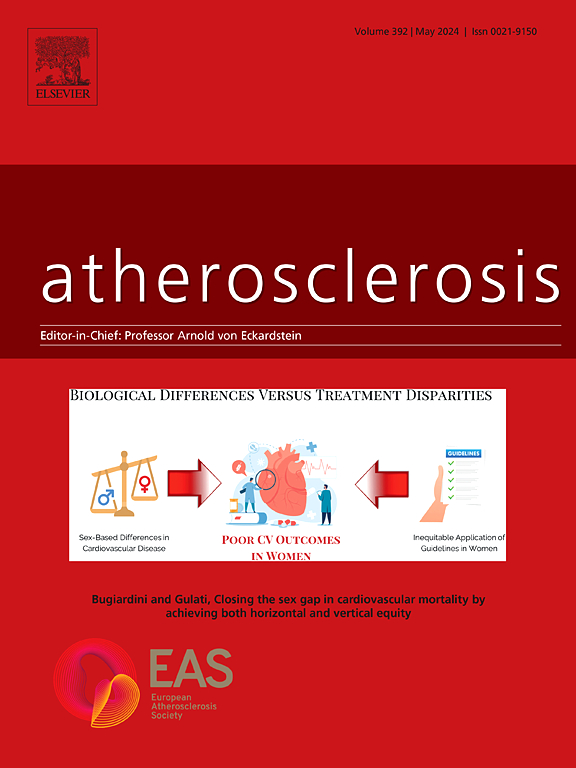Residual lipoprotein(a)-associated risk in patients with stroke or transient ischemic attack
IF 5.7
2区 医学
Q1 CARDIAC & CARDIOVASCULAR SYSTEMS
引用次数: 0
Abstract
Background and aims
Lipoprotein (a) [Lp(a)] is a genetically determined risk factor for atherosclerotic cardiovascular diseases. This study aimed to evaluate the association of serum Lp(a) levels with the risk of residual vascular event risk after stroke or transient ischemic attack (TIA) in the Japanese population.
Methods
In this prospective observational study, 533 patients (mean age, 70.7 years; female, 41.8 %) with ischemic stroke (n = 496) or high-risk TIA (n = 37) were consecutively enrolled within 1 week of onset and followed up for 1 year. Patients were divided into 2 groups according to the median baseline Lp(a) levels: (i) low (≤15 mg/dL, n = 270) and (ii) high (>15 mg/dL, n = 263) Lp(a) groups. The primary endpoint was a composite of major adverse cardiovascular events (MACEs), including nonfatal stroke, nonfatal acute coronary syndrome, and vascular death.
Results
Compared to patients with Lp(a) ≤15 mg/dL, those with Lp(a) > 15 mg/dL were more likely to have extracranial carotid artery stenosis (8.8 % versus 15.2 %; p = 0.024) and a history of coronary artery disease (7.8 % versus 14.1 %; p = 0.019). Elevated Lp(a) levels were independently associated with an increased risk of MACE (annual rate, 10.7 % versus 19.1 %; log-rank p = 0.009; adjusted hazard ratio, 1.68; 95 % confidence interval, 1.03–2.72; p = 0.037). When patients were classified according to the etiologic subtype of the index event, elevated Lp(a) was a significant predictor of MACE in patients with atherothrombotic stroke (annual rate, 14.0 % versus 25.8 %; log-rank p = 0.041), but not in those with small vessel disease, cardioembolism, or cryptogenic stroke.
Conclusions
Elevated Lp(a) levels >15 mg/dL in Japanese patients with stroke are associated with extracranial carotid stenosis and a higher risk of MACE. The measurement of Lp(a) levels helped refine the risk assessment of patients with stroke or TIA.

卒中或短暂性脑缺血发作患者的残留脂蛋白(a)相关风险
背景和目的:脂蛋白(a) [Lp(a)]是动脉粥样硬化性心血管疾病的遗传决定危险因素。本研究旨在评估血清Lp(a)水平与日本人群中风或短暂性脑缺血发作(TIA)后残留血管事件风险的关系。方法在这项前瞻性观察性研究中,533例患者(平均年龄70.7岁;女性(41.8%),缺血性卒中(n = 496)或高危TIA (n = 37)患者,在发病1周内连续入组,随访1年。根据中位基线Lp(a)水平将患者分为2组:(i)低(≤15 mg/dL, n = 270)和(ii)高(≤15 mg/dL, n = 263) Lp(a)组。主要终点是主要不良心血管事件(mace)的综合,包括非致死性卒中、非致死性急性冠状动脉综合征和血管性死亡。结果与Lp(a)≤15 mg/dL患者相比,Lp(a) >;15mg /dL更容易发生颅外颈动脉狭窄(8.8% vs 15.2%;P = 0.024)和冠状动脉病史(7.8%比14.1%;p = 0.019)。Lp(a)水平升高与MACE风险增加独立相关(年发生率,10.7%对19.1%;Log-rank p = 0.009;调整后的风险比为1.68;95%置信区间为1.03-2.72;p = 0.037)。当患者根据指数事件的病因亚型进行分类时,升高的Lp(a)是动脉粥样硬化血栓性卒中患者MACE的重要预测因子(年发病率,14.0%对25.8%;Log-rank p = 0.041),但在小血管疾病、心脏栓塞或隐源性中风患者中不存在。结论日本脑卒中患者Lp(a)水平升高(≥15 mg/dL)与颅外颈动脉狭窄和MACE风险升高相关。Lp(a)水平的测量有助于改进卒中或TIA患者的风险评估。
本文章由计算机程序翻译,如有差异,请以英文原文为准。
求助全文
约1分钟内获得全文
求助全文
来源期刊

Atherosclerosis
医学-外周血管病
CiteScore
9.80
自引率
3.80%
发文量
1269
审稿时长
36 days
期刊介绍:
Atherosclerosis has an open access mirror journal Atherosclerosis: X, sharing the same aims and scope, editorial team, submission system and rigorous peer review.
Atherosclerosis brings together, from all sources, papers concerned with investigation on atherosclerosis, its risk factors and clinical manifestations. Atherosclerosis covers basic and translational, clinical and population research approaches to arterial and vascular biology and disease, as well as their risk factors including: disturbances of lipid and lipoprotein metabolism, diabetes and hypertension, thrombosis, and inflammation. The Editors are interested in original or review papers dealing with the pathogenesis, environmental, genetic and epigenetic basis, diagnosis or treatment of atherosclerosis and related diseases as well as their risk factors.
 求助内容:
求助内容: 应助结果提醒方式:
应助结果提醒方式:


